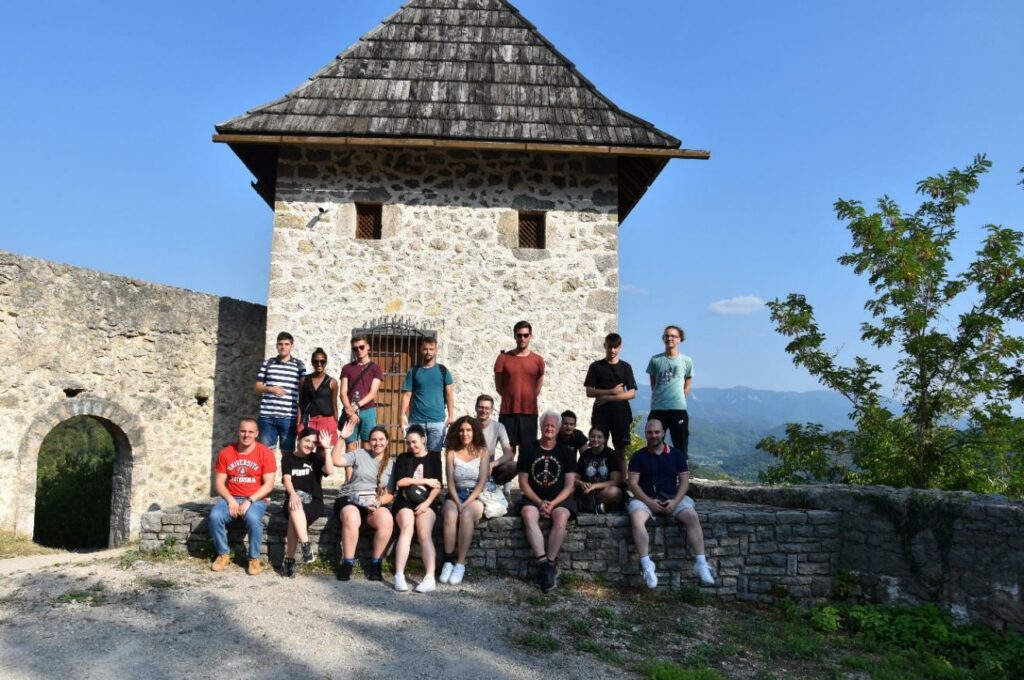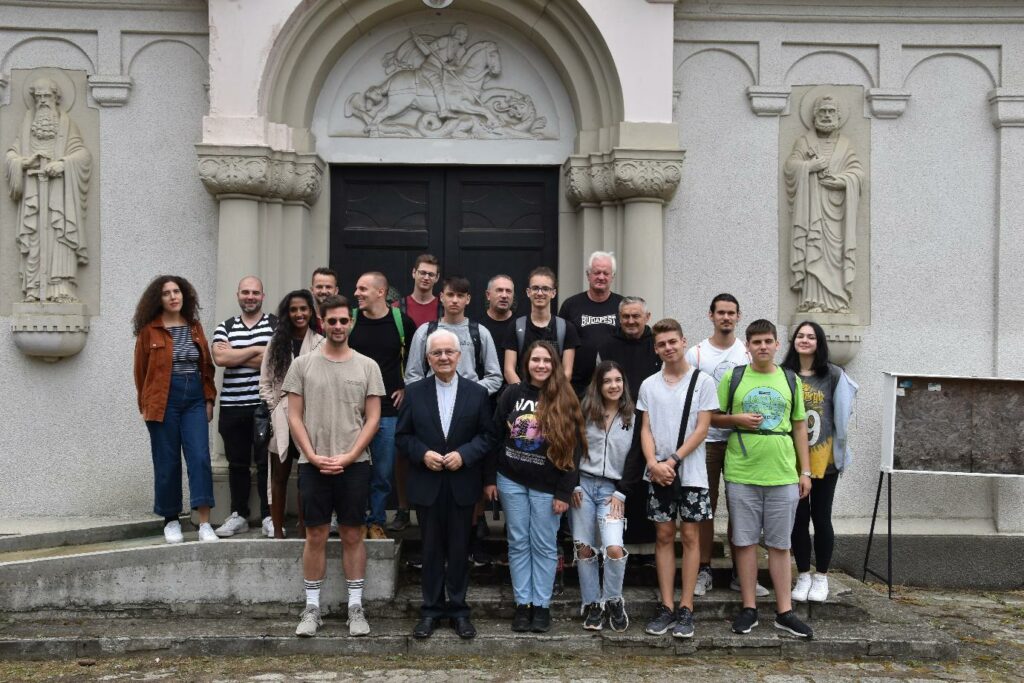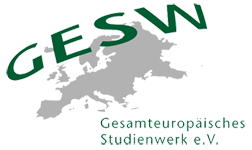International youth seminar in Ključ/Bosnia, August 2022
As the name of the project implies, we have experienced the concept of diversity in Bosnia and Herzegovina. By visiting different places with different religious and ethnic groups we have testified the vividness of diversity in this western Balkan country. A number of workshops on various topics (ethnicity and languages, religions, refugee crisis, economic and social situation) provided valuable information concerning this politically and socially complicated country in Europe.
Between 6th to 14th of August 2022 the project “Living in Diversity”, financed by ErasmusPlus, took place in Ključ and other towns and cities around Bosnia and Herzegovina organized by three different organizations from Romania, Germany and Bosnia. From each organization around six to seven participants between 16 and 30 years of age came together in the house of the Bosnian organization Dinara Forum (Emil Bender). The Romanian organization was Puzzle OptimEast and the German organization the Gesamteuropäisches Studienwerk (Dr. Gerhard Schüsselbauer) in Vlotho.

The first day we spent in Ključ. After breakfast, we met and started with energizers and games to get to know each other better. After the project introduction we divided in different groups to discover and learn more about the city and its ethnical and cultural richness. There was also a price for the group that managed to visit the most places. In the afternoon the group climbed to the old town of Ključ. There we learned more about Bosnia’s and Herzegovina’s religious groups, the country’s history, the economic situation and the situation of refugees coming from the Mediterranean. In the evening the group socialized and played a song guessing game, with music from the participants countries. We continued the workshops the next day on various other topics.
On the second day we visited a Serbian Orthodox Church close to Ključ, in the administrative unit of Republika Srpska. The priest we met talked about the monastic life in the church and the geographic situation in the city and the daily life with other religions. In the church we got a live demonstration of orthodox clergy singing, which was impressive.
Following the performance we drove to a historic side to visit a cave, in which the Yugoslav leader Josip Broz Tito was hiding from fascist German occupiers and eventually could escape. There was also a museum and photo exhibition about this time, in the museum store we learned more about the local women’s initiative. Later on we went to the national park Una, which is close to the border with Croatia. We saw fantastic waterfalls and breathtaking landscapes. In the evening we returned to Ključ.
On the third day we stayed in Banja Luka. First, we stopped at an old Catholic monastery belonging the Trappist order. We watched a film about the history of the site and a local catholic bishop talked about Christian faith, its situation in Bosnia and Herzegovina and the rest of Europe. The war in the 1990s and the rising religious tensions in former Yugoslavia were also core topics. One of the provocative core questions the bishop raised is related to the perception who is a European and who is Asian. According to his opinion Central and Western Europeans do still not accept the Balkans as being part of Europe. Only when this perception changes and can be altered we can talk about Europe as a full entity!
The next location on our schedule was a mosque in Banja Luka. Here a young imam introduced us the Islam, the history and structure of a mosque and their daily life in a majorly Serbian orthodox city. Then we went to the city of Jajce where we saw a waterfall and discovered the old town, some of us even went up to see the Citadel. In the evening we returned to Ključ where we gathered and watched a Romanian movie to also foster intercultural exchange.
On Wednesday morning we had to leave early in the morning to ride the long way to Mostar. On our way to Mostar we stopped in Blagaj, which is a little town, with the Vrelo Bune coming out of a mountain, which is the spring of the river Buna. It was interesting to see how many tourists visited the place. After a late lunch we continued our journey to Mostar, which became one of the core symbols of the bloody wars from 1991 to 1996. It was heavily destroyed while the famous bridge – a symbol of reconciliation – was rebuilt only in 2004.
The next day we had two appointments, before continuing to Sarajevo. We visited two churches, one orthodox church on a hill on the city’s periphery and a large catholic monastery in the city center. We experienced the complex religious life which actually can be perceived rather a next-to-each-other that life together! After these visits we continued our journey to Sarajevo. The capital of Bosnia and Hercegovina was under siege from 1992 even till 1996, more than 1400 days, while more than 10.000 people died in this bloodshed, among them more than 1.600 children. A bomb in the market hall killed 68 people in February 1994. Physical wounds are still very much visible, even after more than 25 years. The next day we went to the local Jewish community and synagogue and then to the Saint Anthony Catholic Church from the Franciscan Order. The Jewish life is after the tragedy of the 20th century still very active with some 700 members of the community. Visiting a Jewish prayers house was a marvelous experience. The meeting in the catholic monastery was again very fruitful, as the priest spoke very openminded about past and today’s challenges and complex questions of religious coexistence.
On the last day we reflected on our travels, talked about the ErasmusPlus program, the youth pass and prepared the evaluation of our international seminar. Our workshops and travels taught us much about Bosnia and Herzegovina. Especially our visits to the different religious sites taught us about the rich religious life and complicated historical heritage in the country. Although the main religion in Bosnia is Islam, it coexists with the orthodox and catholic religions. Often the ethnic groups divide along religious lines, Serbs are orthodox, Bosniaks are muslim and Croats are catholic. This division is visible not only in terms of religion, but also regarding the attributed areas of living for each ethnical group in the country, but can be in some regions more or less be mixed. Daily conflicts and problems arise between the peoples at times. We also saw the marks and remains of the war in the 1990s left all over the country and we could better understand how this conflict affected people’s everyday life. To sum up Bosnia and Herzegovina is probably the most complicated country in Europe, when it comes to ethnicity, religion and social life.
One major problem for Bosnian society is that people tend to leave the country, especially the younger generations emigrate for work and a better future. The average age in Ključ for example is even as high as 47 years. What is also quite visible is the huge difference between the working middle-class, people from outside the country, showing up with big and expensive cars and summer houses and the much poorer local population. The diaspora from all over Europe tends to come in summer to spend the holidays back home and invest money in their former hometown, nevertheless show what they have achieved abroad. This contrast is visible everywhere in Bosnia and Herzegovina where hundreds of thousands of people have left in the last 30 years.
Change
The society in Bosnia and Herzegovina has changed and it is still changing. Due to the recent war and all atrocities that took place in this country, the population decreased drastically. Before the war, the number of inhabitants in 1991 in BiH was 4,7 million. According to the last census from 2013, there are between 3,3 and 3,7 million people in B&H. However, taking into account that many people left the country since 2013, the number is lower than 3 million according to the World Bank. The today’s population is very old and on top of that, the country has a very low birth rate, around 1,6 children per family. Thus, we can conclude that the society and its’ demographic picture are changing and because of this the future is very uncertain for this ex-Yugoslavian republic.
Physical Damages
During the visits to different locations and our journeys throughout B&H, we have noticed a damaged infrastructure. Despite the fact that the war ended in 1995, the physical damages are still visible and present. The abandoned houses next to the road which have not been renovated are the best example for this. Additionally, the façade of the buildings in big cities are a living proof of the bombing and shelling that happened in the 1990ties. The damages in the sacred places (orthodox and catholic churches, synagogues and mosques) are also very visible in spite of many investments that have been allocated here.
Intercultural Dialogue
In the multicultural society it is indispensable to have an intercultural dialogue. B&H has still very diverse society where four big monotheistic religions are represented: Roman Catholic, Serbian Orthodox, Islam and Judaism. The dialogue exists and the members and representatives of the aforementioned religions do interact with each other, however, there are many flaws and obstacles which will be discussed further on while presenting other concepts.
Reconciliation
To foster dialogue and critically reflect about the past is a must in every post-conflict society. This has partially happened in B&H. The reconciliation has happened, but to a certain degree. There are still many open questions which are not being discussed neither in the public discourse nor in the private sphere. What we have perceived is that people tend to victimize themselves of their particular group, and to accuse others that they are more responsible for what happened. All in all, it is a not an honest reconciliation where all sides show empathy and understanding for others.
Taboos
What is actually hindering the full reconciliation are the taboos in the society. There are so many taboo topics which are mostly related to the recent war, but also to the general past of B&H. Questions arise and some doubts as well, but who is going to question what happened? There is a huge pressure and ostracism threat from the ethnic group for those who are critically questioning the past. Those who are courageous to do it, would be excluded from the community and their life would be considerably more difficult and challenging.
Wounds
The open wounds und undiscussed recent history is a mark of the Bosnian-Herzegovinian society. The constant victimization of the own ethnic group and the selective culture of remembrance is predominant in each ethnic group. A lack of self-reflection is evident and desperately needed.
Contrast
What we have noticed in our journeys through B&H is a strong contrast in architecture. But not only contrast between Ottoman, Austro-Hungarian and Communist heritage, but even contrast between houses which are abandoned or not completely renovated, and a well-equipped so called “diaspora houses” which are similar to western European villas, however, the essential difference lies in the fact that the owners of diaspora houses spend 2 or 3 weeks on average in B&H yearly, whereas the rest of the 49 weeks these houses are completely empty. Contrast is also visible in terms of the wealth among the existing social classes. There is a huge gap between the rich and the poor, consequently you have a small middle-class which should supposedly make a balance, but it is not making it because it has been outnumbered by the other two classes.
Neglect
We have testified that all of the ethnic communities stress out the fact that they have been neglected and that the injustice has been done to them. As already mentioned, they rarely reflect about others, but mainly about their needs and aspirations. In fact, all of the groups have been neglected at some point, especially there where they represent minority, and those are precisely the places that we have visited. However, there is no will to show empathy and understanding towards others.
Conservatism
The ethnic groups and the society as a whole have become more conservative in comparison to the pre-war period. The inter-ethnic marriages are very rare, if even existent. The members of the ethnic group tend to marry exclusively within the same group. The phenomenon of the two schools under one roof is still present and this causes even more conservatism within already conservative society.
Past
In conversations and exchange with the religious preachers and leaders, we have concluded that they always recall the past and the past events. In other words, they are not forward-looking. A radical change is needed and it can all come from the younger generations.

